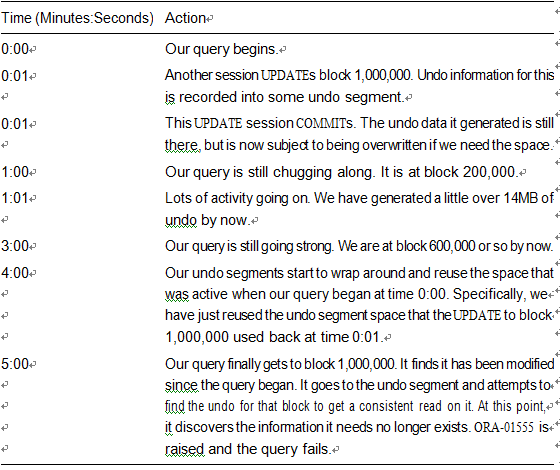Undo Segments Are in Fact Too Small -Redo and Undo-1
The scenario is this: you have a system where the transactions are small. As a result, you need very little undo segment space allocated. Say, for example, the following is true:
•\ Each transaction generates 8KB of undo on average.
•\ You do five of these transactions per second on average (40KB of undo per second, 2400KB per minute).
•\ You have a transaction that generates 1MB of undo that occurs once per minute on average. In total, you generate about 3.5MB of undo per minute.
•\ You have an exceedingly small amount of undo configured for your system.
That is more than sufficient undo for this database when processing transactions. The undo segments will wrap around and reuse space about every three to four minutes or so, on average. If you sized undo segments based on your transactions that do modifications, you did all right.
In this same environment, however, you have some reporting needs. Some of these queries take a really long time to run—five minutes, perhaps. Here is where the problem comes in. If these queries take five minutes to execute and they need a view of the data as it existed when the query began, you have a very good probability of the ORA-01555 error occurring.
Since your undo segments will wrap during this query execution, you know that some undo information generated since your query began is gone—it has been overwritten. If you hit a block that was modified near the time you started your query, the undo information for this block will be missing, and you will receive the ORA- 01555 error.
Here’s a small example. Let’s say we have a table with blocks 1, 2, 3, … 1,000,000 in it.
Table 9-2 shows a sequence of events that could occur.
Table 9-2. Long-Running Query Timeline

This is all it takes. If your undo segments are sized such that they have a good chance of being reused during the execution of your queries, and your queries access data that will probably be modified, you stand a very good chance of hitting the ORA-01555 error on a recurring basis. If this is the case, you must set your UNDO_RETENTION parameter higher and let Oracle take care of figuring out how much undo to retain (this is the suggested approach; it’s much easier than trying to figure out the perfect undo size yourself) or resize your undo segments and make them larger (or have more of them). You need enough undo configured to last as long as your long-running queries. The system was sized for the transactions that modify data—you forgot to size for the other components of the system.
There are two methods to manage undo in the system:
•\ Automatic undo management: Here, Oracle is told how long to retain undo for, via the UNDO_RETENTION parameter. Oracle will determine how many undo segments to create based on concurrent workload and how big each should be. The database can even reallocate extents between individual undo segments at runtime to meet the UNDO_RETENTION goal set by the DBA. This is the recommended approach for undo management.
•\ Manual undo management: Don’t use this method. This is a relic of the early versions of Oracle.
With manual undo management, DBAs had the choice of manually setting the size and number of the undo segments. Don’t use the manual method. Knowledge of this topic is really only relevant when trying to impress older DBAs on the team.
Under automatic undo management, things are much easier from the ORA-01555 perspective. The DBA first creates an autoextending undo tablespace and then tells the database how long the longest-running query (or flashback operation) is and sets that value in the UNDO_RETENTION parameter. Oracle will attempt to preserve undo for at least that duration of time. If sufficient space to grow has been allocated, Oracle will extend an undo segment and not wrap around—in trying to obey the UNDO_RETENTION period. This is in direct contrast to manually managed undo, which will wrap around and reuse undo space as soon as it can. It is primarily for this reason, the support of the UNDO_RETENTION parameter, that I highly recommend automatic undo management whenever possible. That single parameter reduces the possibility of an ORA-01555 error greatly (when it is set appropriately).
